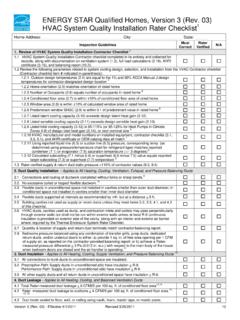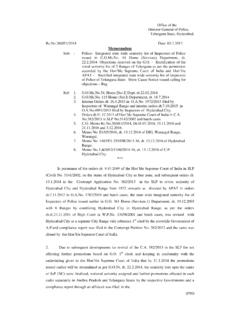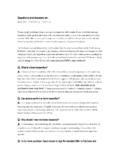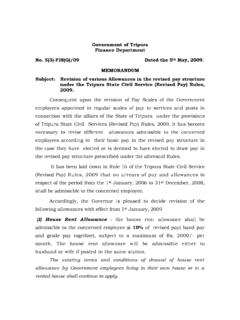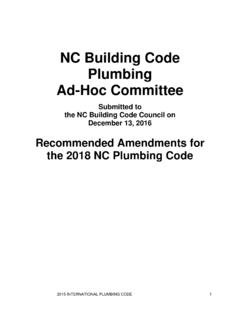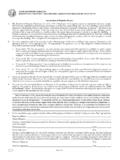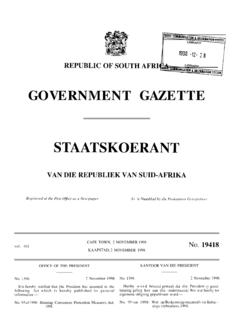Transcription of The 2012 North Carolina Energy Code for Buildings
1 1 The 2012 North Carolina Energy code for Buildings Presented byJeff Tiller, PEAppalachian State University, Boone, NC NC Residential Energy Code2 Section 301 2012 IECC Climate ZonesNC Climate Zones: 3, 4, 53 Unconditioned basementUnconditioned Crawl spaceWhat s Inside What s Inside #2: Redefined building Envelope4 Energy EFFICIENCY , Permit Holder or Registered Design Professional Print Name:Signature: Property Address: Date: Insulation Rating - List the value covering largest area to all that applyR-ValueCeiling/roof:R-Wall:R-Floor: R-Closed Crawl Space Wall:R-Closed Crawl Space Floor:R-Slab:R-Basement Wall:R-Fenestration:U-Factor Solar Heat Gain Coefficient(SHGC) building Air Leakage o Visually inspected according to ORo building Air Leakage Test Results (Sec. )ACH50 [Target: ] or CFM50/SFSA [Target: ]Name of Tester / Company:Date: Phone:Ducts:Insulation R-Total Duct Leakage Test Result (Sect.)
2 (CFM25 Total/100SF) [Target: 6]Name of Tester or Company:Date: Phone:Certificate to be displayed permanentlyAPPENDIX E-1: RESIDENTIAL REQUIREMENTSE nergy Efficiency Certificate (Section )TABLE AND FENESTRATION REQUIREMENTS BY COMPONENTCLI-MATEZONEFENE-STRA-TIONU-FAC TORbSKY-LIGHTbU-FA C TO RGLAZEDFENE-STRA-TIONSHGCb, eCEILINGR-VALUEkWOODFRAME WALLR-VALUE eMASSWALLR-VALUEiFLOORR-VALUEBASE-MENTcW ALLR-VALUESLABdR-VA L U E& or 30 cont. j15, 13+ 135 or 30 cont. j19, 13+5, or 15+3eh13/17 30g10/131010/ 135 Notes from Previous R-Value Charta. R-values are minimums. U-factors and SHGC are The fenestration U-factor column excludes skylights. The SHGC column applies to all glazed 10/13 means R-10 continuous insulated sheathing on the interior or exterior of the home or R-13 cavity insulation at the interior of the basement wall or crawl space wall.
3 D. For monolithic slabs, insulation shall be applied from the inspection gap downward to the bottom of the footing or a maximum of 18 inches below grade whichever is less . For floating slabs, insulation shall extend to the bottom of the foundation wall or 24 inches, whichever is less. (See Appendix O) R-5 shall be added to the required slab edge R-values for heated R -19 fiberglass batts compressed and installed in a nominal 2 6 framing cavity is deemed to comply. Fiberglass batts rated R-19 or higher compressed and installed in a 2x4 wall is not deemed to comply. f. f. Basement wall insulation is not required in warm-humid locations as defined by Figure (1 and 2) and Table from Previous R-Value Chart (cont.)g. Or insulation sufficient to fill the framing cavity, R-19 13+5 means R-13 cavity insulation plus R-5 insulated sheathing.
4 15+3 means R-15 cavity insulation plus R-3 insulated sheathing. If structural sheathing covers 25 percent or less of the exterior, insulating sheathing is not required where structural sheathing is used. If structural sheathing covers more than 25 percent of exterior, structural sheathing shall be supplemented with insulated sheathing of at least R-2. 13+ means R-13 cavity insulation plus For Mass Walls, the second R-value applies when more than half the insulation is on the interior of the mass R-30 shall be deemed to satisfy the ceiling insulation requirement wherever the full height of uncompressed R-30 insulation extends over the wall top plate at the eaves. Otherwise R-38 insulation is required where adequate clearance exists or insulation must extend to either the insulation baffle or within 1 of the attic roof deck.
5 K. Table value required except for roof edge where the space is limited by the pitch of the roof, there the insulation must fill the space up to the air FloorsInsulation must be in permanent contact with subfloor aboveMaximum 18 inches between tension supports wires or other devices that hold the floor insulation in shall be no more than 6 inches from the end of the insulationEnclosed floor cavity such as garage ceilings, cantilevers, or Buildings on pilings with enclosed floor cavity with the insulation fully in contact with the lower air barrier. In the case the band boards will be insulated to maintain thermal envelope continuityFloor Insulation: Exception to floor cavity must be enclosed and insulation must be at either bottom or top (but not both)!7 Cantilevered FloorsUsed to require ceiling R-value; now requires floor R-valueBut.
6 How s this house doing? Framed cavity walls (cont.)For framed walls, the cavity insulation shall be enclosed on all sides with rigid material or an air barrier material. Wall insulation shall be enclosed at the following locations: Tubs, Showers, Stairs, Fireplace units, Attic Knee-Walls8 All Attic Knee-walls of any type require solid backing enclosing the insulationSolid Air-Barrier required in framed out areas such as fireplaces9 What about behind tubs & showers?Solid Air-Barrier required behind showers and bath tubs10 Sealing Framed-In AreasAvoid this problemFloor framing under kneewallsMinimum 1 3/8 solid-wood, insulated door, or minimum foam insulation attached to site-built blocking between insulated attic floor and floor under heated space11 Avoid These ProblemsKnee Walls Need BlockingBlocking between joists needed to prevent air in attic from flowing under bonus room floor12 Solid Framing: Blocking & SheathingJoist cavities under attic knee-walls must be blockedAir Sealing building thermal envelopeThe building thermal envelope shall be durably sealed with an air barrier system to limit infiltration.
7 The sealing methods between dissimilar materials shall allow for differential expansion and contraction. For all homes, where present, the following shall be caulked, gasketed, weatherstripped or otherwise sealed with an air barrier material, or solid material consistent with Appendix of this code :1. Blocking and sealing floor/ceiling systems and under knee walls open to unconditioned or exterior Capping and sealing shafts or chases, including flue Capping and sealing soffit or dropped ceiling Sealing HVAC register boots and return boxes to subfloor or envelope tightness shall be considered acceptable when items providing insulation enclosure in and air sealing in are addressed and when the items listed in Table , Visual inspection to the method of construction, are certified by the builder, permit holder or registered design professional via the certificate in Appendix penetrations through the building thermal envelope, including those for plumbing, electrical wiring, ductwork, security and fire alarm wiring, and control wiring.
8 Shall be separationAir sealing is provided between the garage and conditioned spaces. An air barrier system shall be installed between the ceiling system above the garage and the ceiling system of interior bootsSealing HVAC register boots and return boxes to subfloor or lightingRecessed light fixtures are air tight, IC rated, and sealed to fixtures not penetrating the building (continued)14 building envelope tightness shall be considered acceptable when items providing insulation enclosure in and air sealing in are addressed and when tested air leakage is less than or equal to one of the two following performance measurements1. CFM50/Square Foot of Surface Area (SFSA) or 2. Five (5) air changes per hour (ACH50) Testing option. Testing shall be reported by the permit holder, a NC licensed general contractor, a NC licensed HVAC contractor, a NC licensed Home Inspector, a registered design professional, a certified BPI Envelope Professional or a certified HERS rater.
9 Testing Programmable the primary heating systemis a forced-air furnace, at least one thermostat per dwelling unit shall be capable of controlling the heating and cooling system on a daily schedule to maintain different temperature set points at different times of the day. This thermostat shall include the capability to set back or temporarily operate the system to maintain zone temperatures down to 55 F (13 C) or up to 85 F (29 C). Heat pump supplementary heat (Mandatory Requirements). Heat pumps having supplementary electric-resistance heat shall have controlsthat, except during defrost, prevent supplemental heat operationwhen the heat pump compressor can meet the heating load. A heat strip outdoor temperature lockout shall be provided to prevent supplemental heat operation in response to the thermostat being changed to a warmer setting.
10 The lockout shall be set no lower than 35 F and no higher than 40oF. 16 Ductwork (Duct) Insulation (Prescriptive). Supply and return ducts in unconditioned space and outdoors shall be in insulated to R-8. Supply ducts inside semi-conditioned spaceshall be insulated to R-4; return ducts inside conditioned and semi-conditioned space are not required to be insulated. Ducts located inside conditioned space are not required to be insulated other than as may be necessary for preventing the formation of condensation on the exterior of cooling ducts, air handlers, filter boxes and building cavities used as ducts shall be sealed. Joints and seams shall comply with Part V Mechanical, Section of the North Carolina Residential Sealing (Mandatory Requirements). Total duct leakage less than or equal to 6 CFM (12 L/min) per 100 ft2 ( m2) of conditioned floor area served by that system when tested at a pressure differential of inches (25 Pa) across the entire system, including the manufacturer s air handler enclosure.
